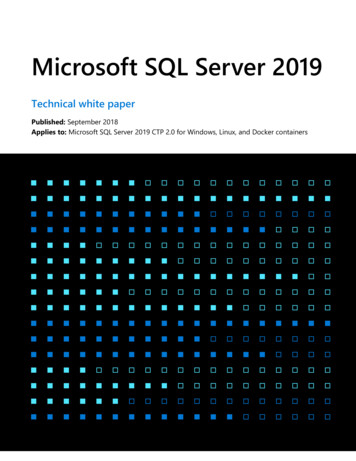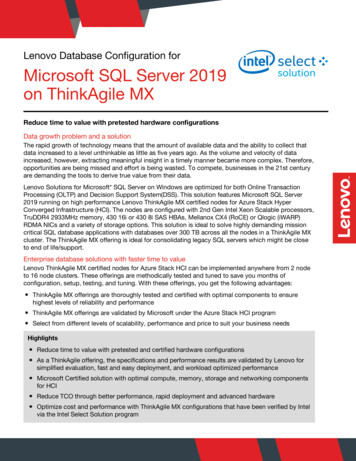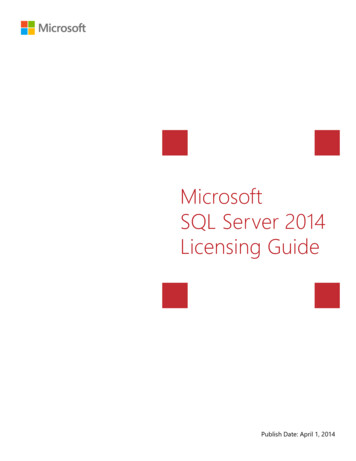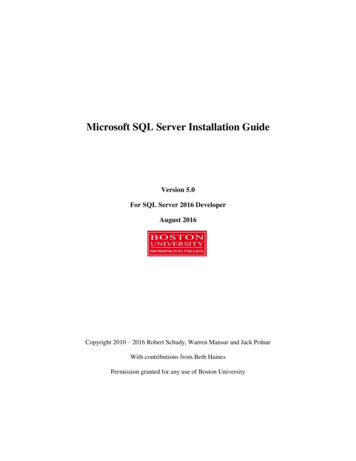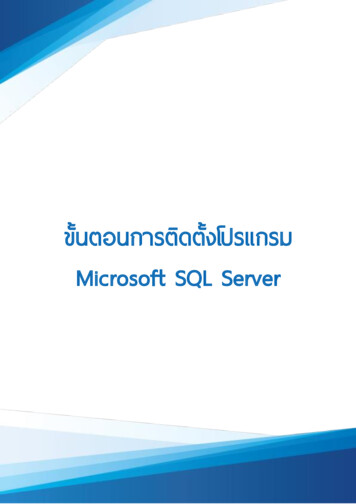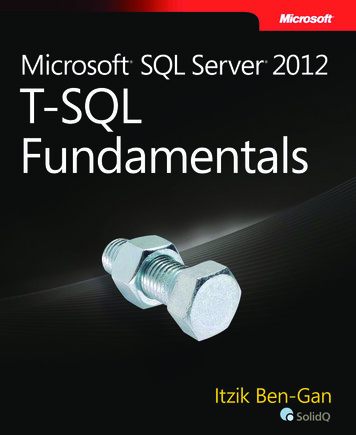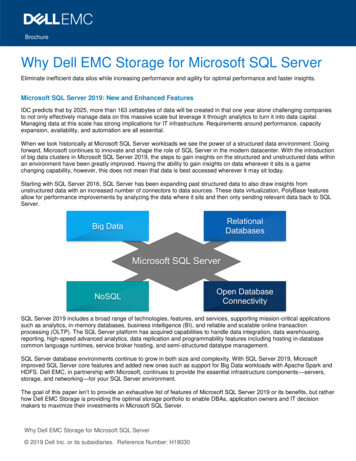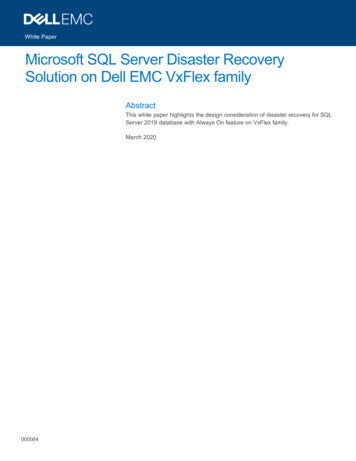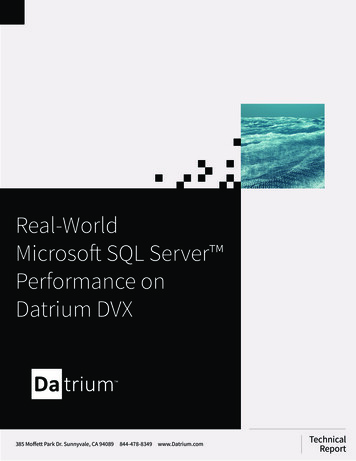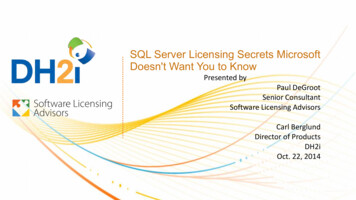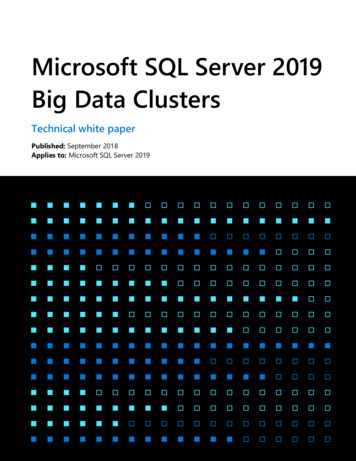
Transcription
Microsoft SQL Server 2019Big Data ClustersTechnical white paperPublished: September 2018Applies to: Microsoft SQL Server 2019
CopyrightThe information contained in this document represents the current view of Microsoft Corporation on the issues discussed as of the date ofpublication. This content was developed prior to the product or service’ release and as such, we cannot guarantee that all details includedherein will be exactly as what is found in the shipping product. Because Microsoft must respond to changing market conditions, it should notbe interpreted to be a commitment on the part of Microsoft, and Microsoft cannot guarantee the accuracy of any information presented afterthe date of publication. The information represents the product or service at the time this document was shared and should be used forplanning purposes only.This white paper is for informational purposes only. MICROSOFT MAKES NO WARRANTIES, EXPRESS, IMPLIED, OR STATUTORY, AS TO THEINFORMATION IN THIS DOCUMENT.Complying with all applicable copyright laws is the responsibility of the user. Without limiting the rights under copyright, no part of thisdocument may be reproduced, stored in, or introduced into a retrieval system, or transmitted in any form or by any means (electronic,mechanical, photocopying, recording, or otherwise), or for any purpose, without the express written permission of Microsoft Corporation.Microsoft may have patents, patent applications, trademarks, copyrights, or other intellectual property rights covering subje ct matter in thisdocument. Except as expressly provided in any written license agreement from Microsoft, the furnishing of this document does not give youany license to these patents, trademarks, copyrights, or other intellectual property. Information subject to change at any time without priornotice.Microsoft, Active Directory, Azure, Bing, Excel, Power BI, SharePoint, Silverlight, SQL Server, Visual Studio, Windows, and Windows Server aretrademarks of the Microsoft group of companies.All other trademarks are property of their respective owners. 2018 Microsoft Corporation. All rights reserved.Microsoft SQL Server 2019 Big Data Clusters2
ContentsIntroduction . 4Data trends . 5Data virtualization . 5Big data and analytics . 5PolyBase - query over any type of database . 6Scalable, shared, and integrated compute and storage. 7Scale-out data marts . 8A shared data lake: read and write files in HDFS with SQL Server or Spark . 8A complete platform for AI and machine learning . 10Hybrid Deployment and Management Services Built In . 12Cluster administration portal . 12Controller service . 12Hybrid deployment and management . 12Conclusion. 13Calls to action . 13Microsoft SQL Server 2019 Big Data Clusters3
IntroductionFor 25 years, Microsoft SQL Server has been powering data-driven organizations. Relational databases have longbeen the norm and still hold a prominent place in any organization’s data architecture. As the variety of types ofdata and the volume of that data has risen, the number of types of databases has risen dramatically. Today thereare NoSQL databases, graph databases, in-memory databases, and big data provided by an ever-growing numberof software vendors.Over the years, SQL Server has kept pace by adding support for XML, JSON, in-memory, and graph data in thedatabase. It has become a do-it-all, flexible database engine that enterprises can count on for industry-leadingperformance, high availability, and security. However, with its roots in a relational engine, a single instance of SQLServer was never designed or built to be a database engine for analytics on the scale of petabytes or exabytes. Italso was not designed for scale-out compute for data processing or machine learning, nor for storing andanalyzing data in unstructured formats, such as media files.SQL Server 2019 extends its unified data platform to embrace big and unstructured data by integratingSpark and HDFS into a “big data cluster”.The SQL Server 2019 relational database engine in a big data cluster leverages an elastically scalable storage layerthat integrates SQL Server and the Hadoop Distributed File System (HDFS) to scale to petabytes of data storage.The Spark engine that is now integrated into SQL Server enables data engineers and data scientists to harness thepower of open source data preparation and query programming libraries to process and analyze high-volumedata in a scalable, distributed, in-memory compute layer.SQL Server 2019 big data clusters with enhancements to PolyBase act as a data hub to integrate structured andunstructured data from across the entire data estate–SQL Server, Oracle, Teradata, MongoDB, HDFS, and more–using familiar programming frameworks and data analysis tools.When SQL Server 2017 added support to run on Linux, it opened the possibility of deeply integrating SQL Serverwith Spark, HDFS, and other big data components that are primarily Linux-based. SQL Server 2019 big dataclusters take that to the next step by fully embracing the modern architecture of deploying applications–evenstateful ones like a database–as containers on Kubernetes. Deploying SQL Server 2019 big data clusters onKubernetes ensures a predictable, fast, and elastically-scalable deployment, regardless of where it is deployed. Bigdata clusters can be deployed in any cloud where there is a managed Kubernetes service, such as AzureKubernetes Service (AKS), or in on-premises Kubernetes clusters, such as AKS on Azure Stack. Built-inmanagement services provide log analytics, monitoring, backup, and high availability through an administratorportal, ensuring a consistent management experience wherever a big data cluster is deployed.SQL Server 2019 big data clusters provide a complete AI platform. Data can be easily ingested via Spark Streamingor traditional SQL inserts and stored in HDFS, relational tables, graph, or JSON/XML. Data can be prepared byusing either Spark jobs or Transact-SQL (T-SQL) queries and fed into machine learning model training routines ineither Spark or the SQL Server master instance using a variety of programming languages, including Java, Python,R, and Scala. The resulting models can then be operationalized in batch scoring jobs in Spark, in T-SQL storedprocedures for real-time scoring, or encapsulated in REST API containers hosted in the big data cluster.Microsoft SQL Server 2019 Big Data Clusters4
Data trendsData virtualizationRecognizing that different storage technologies are more appropriate for different types of data, an organizationis likely to have data stored in a mixture of relational and non-relational data stores—often from several differentvendors. A challenge for developers, data scientists, and analysts is that to extract value from this data, theytypically need to combine data from these disparate sources. This problem is normally addressed by moving orcopying all the relevant data from the source systems together on a single platform.In traditional business intelligence systems, copies of data are created and loaded into a reporting platform withextract-transform-load (ETL) processes. Reporting and analysis are then carried out on these copies. Whileenabling enterprises to extract business value from their data, ETL processes have several issues: Development, maintenance, and support challenges: If they are to be repeatable and robust, ETL pipelinesrequire effort to create, effort to keep them up to date, and effort to keep them running, especially as datamodels change over time.Data latency: ETL pipelines introduce an inherent delay. A recent study 1 found that more than 80% of datasets delivered by ETL pipelines is between 2 and 7 days old by the time it reaches an analytical system. 75% ofbusinesses reported that delays in data processing had inhibited business opportunities.Increased vulnerability: Each copy of a data set must be secured against unauthorized access. It is difficult toconsistently secure multiple copies of the data in disparate data storage and access systems.Increased storage costs: Each copy of a data set requires disk space to store, and these costs can besubstantial if a data set is very large or is copied many times.Compliance challenges: As data is copied or moved around, the complexities of the governance of that datais multiplied, especially for organizations that are subject to strict data regulations such as GDPR.While ETL has a its use cases, an alternative to ETL is data virtualization, which integrates data from disparatesources, locations, and formats, without replicating or moving the data, to create a single "virtual" data layer. Datavirtualization enables unified data services to support multiple applications and users. The virtual data layer—sometimes referred to as a data hub—allows users to query data from many sources through a single, unifiedinterface. Access to sensitive data sets can be controlled from a single location. The delays inherent to ETL neednot apply; data can always be up to date. Storage costs and data governance complexity are minimized.Big data and analyticsWith the onset of the Internet of Things (IoT), connected devices and people are generating volumes of data thatexceed the storage capacity of any traditional database system. By some estimates2, 90% of all the data in theworld was generated in the last 2 years at a rate of 2.5x1018 bytes of data per day. This new type of data is often informats that are not suitable for storing in relational database tables or for querying using relational querysemantics.The Apache Hadoop project introduced new technologies–storage in the Hadoop Distributed File System (HDFS),resource scheduling in YARN, and parallel compute query engine in MapReduce–to help store and analyze thisnew type of data known as “big data”. The big data ecosystem has evolved over time and now there are many13rd Platform Information Management Requirements Survey, IDC, October, 2016, n 5022“How Much Data Do We Create Every Day? The Mind-Blowing Stats Everyone Should Read,” 2018, Forbes.comMicrosoft SQL Server 2019 Big Data Clusters5
other components of a big data architecture that play a role in some aspect of a big data cluster, such as Knox orRanger for security, Hive for providing structure around the data and enabling SQL queries over HDFS data, andmany more.The Apache Spark project added a powerful, new analytics engine to the big data ecosystem. Spark enablesdistributed, scalable compute to execute Java, Python, Scala, or R code on data stored in HDFS or other datasources. Data in Spark is cached in memory for super-fast data access. Spark is up to 100x faster than a HadoopMapReduce query. Data scientists and engineers can use a rich and ever-expanding library of Python, R, Java, andScala open-source code libraries to ingest and manipulate data, query it, and build and operationalize machinelearning models.PolyBase - query over any type of databaseFirst added to the SQL Server database engine in SQL Server 2016, PolyBase enables applications and users toquery big data stored in HDFS-compatible Hadoop distributions and file systems such as HortonWorks, Cloudera,and Azure Blob Storage by using T-SQL to define an external table to represent HDFS data in SQL Server. Users orapplications can run T-SQL queries that reference the external table as if it were a normal SQL Server table. Whenthe query is executed, data from the external data source is retrieved and returned to the user, but it is not storedin persistent storage in SQL Server.Using this approach of querying data from the source ensures that there are no data latencies, duplicated storagecosts, or data-quality issues introduced by ETL pipelines. Once you have created external tables in SQL Server, youcan control access to data sources by granting access to external tables to Active Directory users and groups, thuscentralizing the data access policies to a single location.SQL Server 2019 extends the capabilities of PolyBase with new connectors to create external tables that link to avariety of data stores, including SQL Server, Azure SQL DB, Azure SQL DW, Oracle, Teradata, MongoDB, AzureCosmosDB, or any ODBC-compliant data source via a generic ODBC driver.Microsoft SQL Server 2019 Big Data Clusters6
Figure 1: Data sources that can be integrated by PolyBase in SQL Server 2019In some data query scenarios, data virtualization across multiple data sources is inherently slower than reading thedata from a single system. To alleviate the performance impact of virtualizing the data, PolyBase and SQL Server2019 big data clusters employ a variety of technologies and techniques to parallelize and scale-out compute andcache data.PolyBase optimizes performance by using push-down computation. Operations such as projections, predicates,aggregates, limits, and homogeneous joins are pushed to the source system to take advantage of the queryoptimizer in each of the source systems. Only the filtered results of these operations are returned to SQL Server,which improves performance by reducing the amount of data to transfer.In SQL Server 2019 big data clusters, the SQL Server engine has gained the ability to natively read HDFS files, suchas CSV and parquet files, by using SQL Server instances collocated on each of the HDFS data nodes to filter andaggregate data locally in parallel across all of the HDFS data nodes.Performance of PolyBase queries in SQL Server 2019 big data clusters can be boosted further by distributing thecross-partition aggregation and shuffling of the filtered query results to “compute pools” comprised of multipleSQL Server instances that work together. Big data cluster administrators can quickly create or remove computepools with command-line tools, the administrator portal, or APIs, giving them the flexibility to elastically scale thecompute resources up or down depending on demand. Resource governance policies can be applied to computepools to control who can use the compute resources. Unlike the scale-out groups of PolyBase in a SQL Server2017 instance, SQL Server 2019 big data clusters can have any number of compute pools with any number of SQLServer instances in each of them. Scale-out nodes in a SQL Server 2017 PolyBase scale-out group must beindividually installed and configured, but compute pools with many SQL Server instances can be provisioned ascontainers on a Kubernetes cluster with a single command or API call in seconds.Scalable, shared, and integrated compute and storageSQL Server, as with other relational databases, has historically been a scale-up system. To handle more data or getbetter performance, a bigger or faster server is required. Although the computing power and storage capacity oftoday’s servers is staggering, there are practical and physical limits to the size of a single server. SQL Server 2019big data clusters deeply integrate the SQL Server engine with leading big data technologies in a single packagesupported by Microsoft that gives SQL Server new abilities to scale-out compute and storage independently.SQL Server 2019 big data clusters take the form of SQL Server and big data services running as pods of containersin different types of “pools”: A compute pool is a group of SQL Server pods used for parallel ingestion of data from an external source–such as Oracle, HDFS, or another SQL Server–and for cross-partition aggregation and shuffling of the data aspart of a query.A storage pool is a group of pods containing SQL Server engine, HDFS data node, and Spark containers. Thisprovides the scalable storage tier along with the collocated compute for SQL Server and Spark right next tothe data.A data pool is a group of SQL Server engine pods that is used either to cache data from an external source orto store an incoming stream of append-only data. In either case, the data is partitioned and distributed acrossall of the SQL Server instances in the pool.The master pool is a special, singleton pool of SQL Server pods that can be either a singleton SQL Server or aSQL Server deployed as multiple instances in an Always On Availability Group for high availability and readMicrosoft SQL Server 2019 Big Data Clusters7
scale out. This SQL Server instance is where read-write OLTP or dimensional data is stored in a big datacluster.Each of these pools can be independently scaled up and down to have more or fewer pods as demand changes. Inthe case of compute pools and data pools, multiple pools can be provisioned each with multiple pods.Scale-out data martsWhen you combine the enhanced PolyBase connectors with SQL Server 2019 big data clusters data pools, datafrom external data sources can be partitioned and cached across all the SQL Server instances in a data pool,creating a “scale-out data mart”. There can be more than one scale-out data mart in a given data pool, and a datamart can combine data from multiple external data sources and tables, making it easy to integrate and cachecombined data sets from multiple external sources.Figure 2: Using a scale-out data pool to cache data from external data sources for better performanceA shared data lake: read and write files in HDFS with SQL Server or SparkFor persistence in a SQL Server big data cluster, SQL Server instances in the data pool can read from and writedata to parquet and CSV files in HDFS to use it as a persisted store. SQL Server and Spark can both read and writethese files, creating a shared data lake. Applications and analytics querying the data from the SQL Server masterinstance and Spark jobs can all simultaneously query the data and get the same result. This creates a data lakethat can be accessed by many different types of users, tools, and systems without hav
query big data stored in HDFS-compatible Hadoop distributions and file systems such as HortonWorks, Cloudera, and Azure Blob Storage by using T-SQL to define an external table to represent HDFS data in SQL Server. Users or applications can run T-SQL queries that reference the ext

